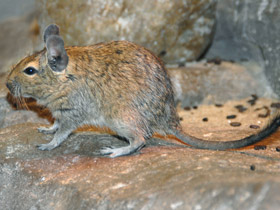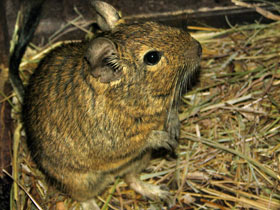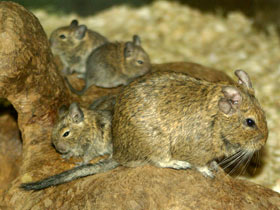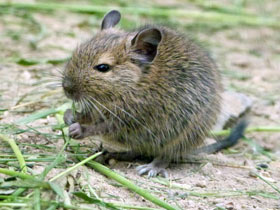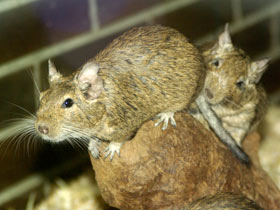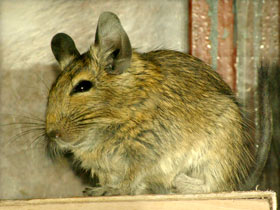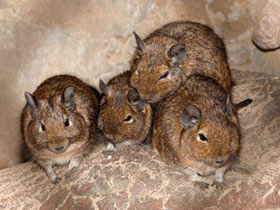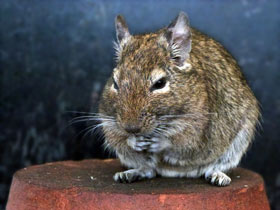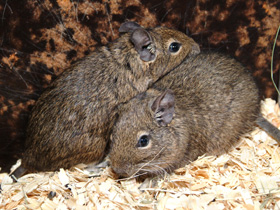The common degu (Octodon degus), or degu
Common degu видео
The common degu (Octodon degus; /ˈdeɪɡuː/), or, historically, the degu, is a small hystricomorpha rodent endemic to the Chilean matorral ecoregion of central Chile. The name degu on its own indicates either the entire genus Octodon or, more commonly, just the common degu. Common degus belong to the parvorder Caviomorpha of the infraorder Hystricognathi, along with the chinchilla and guinea pig. The word degu comes from the indigenous language of Chile, Mapudungun, and the word dewü, meaning 'mouse' or 'rat'.
The animal may be kept as a domestic pet, though there are prohibitions on their ownership in some territories. As a pet, the animal is larger than a golden hamster but smaller than a fancy rat.
Description
The common degu is a small animal with a body length of 25.0 to 31.0 cm (9.8–12.2 in) and a weight of 170 to 400 g (6.0 to 14.1 oz). It has yellow-brown fur above and creamy-yellow below, with yellow around the eyes and a paler band around the neck. It has a long, thin tail with a tufted, black tip, dark sparsely furred ears, and pale grey toes. Its fifth toe is small with a nail, rather than a claw, on the fore feet. Its hind feet are bristled. Its cheek teeth are shaped like figures-of-eight, hence the degu's genus name Octodon.
Habitat, lifestyle and habits
Octodon degus are these small South American rodents with strong hind legs that can jump up to 1 metre high. They have a rounded head with a flat nose, a short and stocky neck, a curved back and a stiff furred tail with a beautiful tassel at the end. The tail of Octodon degus, as well as other representatives of rodents, has a peculiarity, which consists in the fact that at a sharp jerk for it, the skin covering the tail, easily removed from the musculoskeletal basis "stocking". The remainder of the tail then shrivels up, and the place where it was, quickly heals. This loss later causes the animal some difficulty in jumping and climbing, but allows it to save its life.
Social behaviour
Octodon degus are extremely social and live in clans of up to 10 adults, with an average of five females per male. Each group has its own nesting and foraging territory, which actively defends from outsiders. Unlike most other rodents, degus are diurnal animals. Like squirrels, they store food in their burrows and feed mainly on dried leaves, hay and grains in winter. Pregnancy in Octodon degus lasts from 87 to 93 days, and there are 3 to 10 babies in a litter. They are born covered with fur, with sufficiently developed teeth and partially opened eyes. The female feeds the offspring with milk for 5-6 weeks. In nature, it has been observed that parents bring young grass to the cubs in the burrow. Baby degus reach the size of adult animals only by the age of 6 months.
Diet
Common degus are strictly herbivorous, in the wild feeding on grasses and browsing the leaves of shrubs, though they will also take seeds. Throughout much of the year forage is dried and so common degus are specially adapted to a very high fibre intake, and this varies between food types and environmental conditions. Like some other herbivores such as rabbits, they perform coprophagy (faecal reingestion) so as to extract more nutrition from their diet. This also serves to maintain healthy gut function during times when food is scarce. Although they are active by day, in high summer they do not leave their burrows in the middle of the day and instead emerge to forage in the mornings and evenings.
Perhaps the most remarkable feature of common degu physiology is their intolerance of dietary sugar. Common degus have been found to have a divergent insulin structure (one of the hormones that regulate blood glucose level) and so are highly susceptible to developing diabetes mellitus when fed regularly on a diet containing free sugars. This is thought to be due to evolutionary pressure arising from the lack of availability of free sugars in the degu's natural environment. Because of this, the ingredients of non-degu-specific hard feed formulations given to captive common degus should be checked for sugar-laden ingredients, such as molasses, honey, and glucose syrup.
Research subjects
Common degus entered the research spotlight due to their unique relationship with sugar and diabetes, but are also studied for a wide variety of other reasons. Neuroscientists at the Riken Institute in Tokyo, Japan, used common degus for research into tool use in animals with good eye-and-paw coordination, in which they spontaneously learned to use a tiny rake to retrieve out-of-reach seeds. Common degus have also been found to spontaneously stack objects in order of decreasing size. In both cases it is the first time these behaviours have been recorded in animals other than apes and birds.
Another interesting area of common degu research is circadian rhythm function, i.e. the ability of the brain to tell what time of day it is. Degus have the ability to show both diurnal and nocturnal rhythms if the environment permits, allowing a unique opportunity for study. Common degus can take cues that do not relate to day length, such as temperature, melatonin levels and even scents from other degus to adjust their rhythms.
Common degus are also invaluable in development and aging studies. Research has shown that separation anxiety caused by separating pups from their mother from an early age for periods of half an hour or more can cause developmental and behavioural changes in later life, similar to ADHD in humans. In elderly common degus, neural markers have been discovered which are remarkably similar to those in humans with Alzheimer's disease, which is the first time this has been seen in a wild-type rodent.
As pets
After initial interest into common degus as research subjects, they have become popular as pets, though until recently they were seldom found in pet shops. Their advantages over traditional small pets are their diurnal habits, bubbly personalities, the haired tail (as compared to rats and mice) and their lifespan: they are reported to live up to 13 years under ideal circumstances (though a poor gene pool or genetic background often reduces a pet degu's lifespan significantly). The average lifespan of a common degu in captivity is typically around six to eight years of age.
One disadvantage of the common degu as a pet is their predisposition to chewing, due to their continually growing incisor and molar teeth. For this reason, common degus cannot be housed in plastic-bottomed cages typically found in pet stores. A metal cage with multiple levels made for rats and secured double latches works best. It is important to line the levels with grass mats or a soft fabric so that the common degus do not get bumblefoot.
Untamed common degus, as with some other small animals kept as pets, can be prone to biting, but their intelligence makes them easy to tame. Regular non-predatory handling and food offerings help with this transition. It is important to never try to catch a common degu by the tail because the skin and tuft at the end is easily "shed" (pulled off). This helps common degus in the wild elude capture by predators, but it is painful to the creature and the tail end will not grow back. When tail shedding occurs, common degus will chew off the damaged portion. This can reduce the chances of infection.
Common degus often "groom" their human owners with a gentle nibbling action, and readily bond with any person spending time with them. Common degus need regular sand baths, like Chinchillas need dust baths, to keep their coats healthy and free from grease. Chinchilla sand is ideal for this. They should have access to these baths regularly, preferably two or three times a week for half an hour at a time. However, daily sand bathing can make their coats soiled.

















